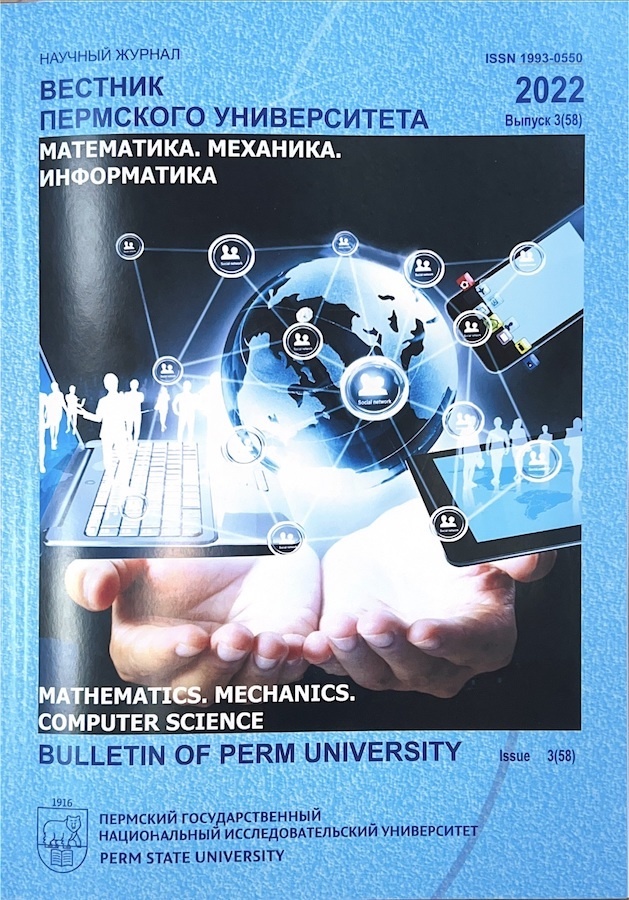№ 1 (64) (2024)
Mathematics
Modified Gerasimov –Caputo Formula
Аннотация
In this work, modified Gerasimov–Caputo formulas were obtained for the first time. The modified formulas take into account the value of the derivative of the function at zero with an order of one less than the order of the derivative under the sign of the Gerasimov–Caputo integral. Without taking into account the new term in the Gerasimov–Caputo formulas, it is not always possible to calculate the fractional derivative on any order interval and for any function. The paper also describes a simple numerical algorithm with the Gaussian quadrature formula, which allows one to calculate the fractional derivative with double precision. tables of fractional derivatives for the sine and cosine functions have been compiled. Moreover, the first half of the tables (in the interval of order (0,1)) and the second half of the tables (in the interval of order (1,2)) were obtained by programs using different algorithms. In the work, an absolute error in calculating the fractional derivative of 10–15 was achieved.
 5-14
5-14


Weakening Incidence Conditions for Subgroups Considered by Algebraists From Perm University
Аннотация
In the first part of this article incidence conditions, introduced and considered by algebraists from Perm University, and information about where and which class of groups are described by them, are given. In the second part, the results, received by algebraists from Perm University in considering of groups with several new generalizations of incidence conditions for noncyclic subgroups, are announced: the formulations of the 14 new theorems proved by them are given. The proofs of these theorems are supposed to be published in a series of separate articles.
 15-23
15-23


Mechanics
The Force Tracking Moment Action on the Gyrostat Motion
Аннотация
The gyrostat moves around a fixed point under the forces influence in pseudo-Euclidean space with signature (3,1). The resulting moment of the external forces system and the gyrostatic moment are specified relative to the coordinate orthoreper, invariably associated with the gyrostat carrier, and are constant. Three types of gyrostat motion are given, in each of which the resulting force vector-moment is collinear to of the main axis of the gyrostat inertia, and the gyrostatic moment is orthogonal to this axis. The vector manifold of the gyrostat angular velocities and the field of its phase trajectories in the state space are found with the parametric integration method using. Integration of the gyrostat motion equations is carried out in quadratures and elliptic functions of time.
 24-32
24-32


Mathematical Models of Temperature and Precipitation Forecasting Using Fractal and Fourier-Analysis of Meteorological Series
Аннотация
The article presents a methodology for constructing statistical models that can be used to predict the temperature regime and precipitation for the upcoming month. Temperature and precipitation are predicted on a two-element scale (high or low parameter value). Within the framework of the considered examples, it was found that temperature is predicted better than precipitation, and recently the accuracy of forecasts tends to increase. The article also provides a detailed analysis of the model parameters, including their change in the annual cycle, trends in the dynamics of change over the past 80 years, and the correlation between climatic parameters. Along with the basic statistical functions of climatic indicators, the models contain fractal parameters (fractal index) and parameters of the discrete Fourier transform (amplitude and phase of the first harmonic). It was found that the fractal indices of monthly series of average daily temperatures is lower than those for monthly series containing daily temperature values.
 33-42
33-42


Computer Science
Computer Modeling of Robust and Adaptive Algorithms in Model-based Design Technology
Аннотация
Automatic digital controllers that ensure the operation of autonomous (on-board or embedded) devices must use robust or adaptive algorithms. To compile a program in C language that implements modern effective control algorithms, model-based design technology (MOP technology) is used, the essence of which is that first a simulation computer model of the automatic control system is being compiled and debugged in a higher-level language, and then the controller operation code for the microprocessor is generated. The article provides an overview of robust and adaptive algorithms that can be used in on-board automatic control systems. Computer models of control systems were built using these algorithms in MATLAB and SimInTech packages, as examples of the initial stages of model-based design technology.
 43-52
43-52


Harmonization Status Analysis of 09.03.01 "Computer Science and Computer Engineering" Disciplines
Аннотация
The article studies the issue of harmonious state of disciplines involved in the educational process of the direction 09.03.01 "Informatics and Computer Science" with the profile "Automated Systems of Information Processing and Control". The information about the methods of key information processing from files with working programs of disciplines is given. The result of data processing is demonstrated. Further perspectives of optimization of students' learning process by building a detailed model of educational program, which will allow to estimate the current level of harmonization with greater accuracy, as well as to supplement the initial model with new useful information, are described.
 53-59
53-59


An Algorithm Creating for Predicting the Inaccurate Information Presence in Social Networks in Russian Language
Аннотация
The development of user-to-user communication methods, such as social media, has resulted in the amount of inaccurate information reaching record levels. This problem affects not only regular users of social media, but also the media, which may refer to such messages as a source of information. The spread of false information leads to both financial and life-threatening problems. It is almost impossible to trace these messages manually and therefore it is required to create an algorithm that can perform this process automatically. The purpose of this paper is to try to create such an algorithm for the Russian language using machine learning methods. The data on which the models are based is a sample of data that has undergone the process of manual annotation. The sample has undergone the process of preparation and balancing. From this sample, 29 attributes were obtained which can be divided into 3 categories: user, text and distribution. These attributes and were applied to obtain classification models that are able to predict with sufficiently high probability. The result of this work is an algorithm for predicting the presence of inaccurate information in a social network post.
 60-71
60-71










